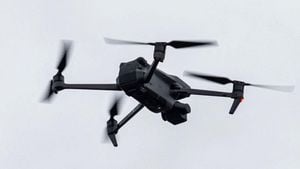Donald Trump’s imminent return to the White House has ignited concerns about the potential for economic turbulence globally, particularly among the currencies of nations heavily tied to the U.S. dollar. Analysts have started to speculate about how Trump’s promised trade policies could trigger not just trade wars, but possibly even currency wars, especially with China. Just as Trump’s first term saw significant tariff escalations, his upcoming policies are casting long shadows over global currency markets.
Trump’s trade strategies have historically favored imposing stiff tariffs on imports, claiming he aims to protect American industries and create jobs domestically. This time, his threats include hefty 25% tariffs on goods from both Canada and Mexico, alongside additional tariffs on Chinese goods which he alleges have been underpriced due to currency manipulation. The stakes are rising, and the conversations surrounding currency valuation are prompting reactions not just from businesses, but also from government officials across the globe.
With Japan, South Korea, and China bracing for impact, the financial sectors within these nations are now focusing on how these tariffs might influence their economies and currencies. For Japan, Prime Minister Shigeru Ishiba faces mounting pressure; his administration’s approval ratings are dwindling, and his government is scrambling to implement economic stimulus measures at the first signs of turbulence. Given Japan’s reliance on exports, any increase of tariffs imposed by Trump could retaliate against Japanese auto manufacturers like Toyota and Honda, already dealing with fragile market conditions.
Economist Gary Hufbauer from the Peterson Institute for International Economics predicts this new trade war will have widespread repercussions, stating, “Trump’s trade approach will be very destructive to the world economy.” His assessment emphasizes how Trump's potential tariffs could reshape trade relationships not just bilaterally, but also regionally across Asia and beyond, with Japan already pushing forward with plans for US$250 billion in stimulus to stave off economic stagnation.
Meanwhile, the Chinese government is on high alert. The yuan’s value is often manipulated by Chinese authorities, and analysts at JP Morgan project the yuan could plummet by 10-15% should the tariffs on Chinese goods materialize. Trump’s plan has reignited fears of competitive devaluations worldwide, where countries attempt to lower their currency's exchange rate to boost export competitiveness without triggering market chaos. A weaker yuan could make Chinese goods cheaper globally, potentially countering the effects of U.S. tariffs.
Already, as Trump’s election victory looms closer, the yuan has seen fluctuations against the U.S. dollar, prompting discussions about whether China may soon employ devaluation as retaliation. With analysts estimating the Chinese currency could reach 7.5 yuan to the dollar, the warning signals are clear for the governing authorities.
To make matters more complicated, Trump’s recent comments about disability payments and the U.S. economy seem to contradict the stability Wall Street investors had hoped for. Economic leaders now watch stored worries evolve as they ponder how the interplay of international pressures combined with Trump’s policies could derail relations inherited by his predecessors.
Even prior to assuming office, markets are feeling jittery, with many outlining not just the impact but the unpredictability of Trump’s trade policies as they relate to currency wars. Last time, tensions with China saw the yuan drop steeply amid Trump’s first term; experts warn similar pitfalls could occur if Trump’s administration opts for aggressive tariffs once again.
The potential resulting instability from trade wars could thrust massive waves through global markets, extending beyond just the scope of U.S. and Chinese economies. It raises questions about how national fiscal policies will adjust to the rapidly shifting terrain created by currency valuations and trade balance expectations.
Still, the debate goes beyond simple numbers. Economists like Arthur Kroeber remind stakeholders constantly: “It’s difficult to predict the future, especially if Donald Trump is involved.” Each turn and strategy shift could signify dramatic currency realignments and adjustments. Past experiences resonate, calling back to when tariffs spurred lower confidence levels among consumers and tightened financial channels worldwide.
While addressing trade disparities remains necessary, observers acknowledge the precarious line between employing responsible economic tactics and provoking currency wars. Investors, especially those invested internationally, feel stuck watching developments unfurl at breakneck speed.
Cabinet appointments will also play pivotal roles as Trump assumes office yet again. His selection of Scott Bessent for Treasury is illustrative of the potential for immediate involvement with currency markets; Bessent is known for his hedge fund experience and influences globally, which could shape the direction of economic policies once they are enacted. All eyes remain glued to the U.S. administration.
Collectively, as trade confrontations arise, the specter of deteriorated diplomatic ties continues to loom between the U.S. and its long-standing partners like Canada and Mexico, alongside stronger adversaries such as China. The upcoming months promise to generate substantial dialogues across economic platforms, enticing discussions of currency manipulation, trade balances, and trade agreements as countries reflect on lessons from previous administrations.
Internationally, central banks begin recalibrations, often altering interest rates and financial strategies to cushion potential shocks from mounting tariffs. Expectations for stability confront the realities of economic trials, pushing several currencies to preemptive positions. Understanding how Trump’s renewed presidency affects individual countries is complex, directing attention not merely to the U.S. but serving as catalysts for changes across multiple financial landscapes.
Investors must also develop strategies to navigate burgeoning risks posed by this dynamic climate. Strategic shift focusing on currency-sensitive investments could attract attention, allowing for responsiveness among agile investors as markets navigate volatility.
Specifically, market watchers will need to anticipate changes not just on the surface but federally, bringing to light how traditional investments might be altered based on initial responses to tariffs if enacted. Engaging discussions spotlight trade agreements and tariffs’ prospective impacts on bilateral relations, intertwining the stability of local currency markets and confidence levels.
With turbulent times lying up ahead, nations balancing power and responsibility tread carefully, watching the impact of Trump’s foreign economic policies ripple through international landscapes. The world stands alert for what seems to be on the horizon, with every new development provoking curiosity about the interrelation of currencies, markets, and trade.
Each matter consequentially impacts trading strategies, where careful positioning against uncertainty is no longer viewed as optional but rather as requisite among investors grappling with market nuances affecting returns on investments.
While potential outcomes remain speculative, the situation unravels, and players across the globe prepare to adjust to adjustments both necessary and foreign, keeping the lines of communication open. Whether these impactful measures determine the course of America’s stance on global trade remains to be seen. Nonetheless, confidence and caution coexist as the situations evolve, with currency wars potentially steering discussions beyond mere financial terms and fostering larger geopolitical narratives.



